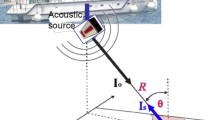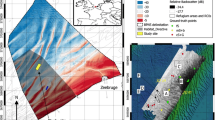Abstract
In this study multibeam angular backscatter data acquired in the eastern slope of the Porcupine Seabight are analysed. Processing of the angular backscatter data using the ‘NRGCOR’ software was made for 29 locations comprising different geological provinces like: carbonate mounds, buried mounds, seafloor channels, and inter-channel areas. A detailed methodology is developed to produce a map of angle-invariant (normalized) backscatter data by correcting the local angular backscatter values. The present paper involves detailed processing steps and related technical aspects of the normalization approach. The presented angle-invariant backscatter map possesses 12 dB dynamic range in terms of grey scale. A clear distinction is seen between the mound dominated northern area (Belgica province) and the Gollum channel seafloor at the southern end of the site. Qualitative analyses of the calculated mean backscatter values i.e., grey scale levels, utilizing angle-invariant backscatter data generally indicate backscatter values are highest (lighter grey scale) in the mound areas followed by buried mounds. The backscatter values are lowest in the inter-channel areas (lowest grey scale level). Moderate backscatter values (medium grey level) are observed from the Gollum and Kings channel data, and significant variability within the channel seafloor provinces. The segmentation of the channel seafloor provinces are made based on the computed grey scale levels for further analyses based on the angular backscatter strength. Three major parameters are utilized to classify four different seafloor provinces of the Porcupine Seabight by employing a semi-empirical method to analyse multibeam angular backscatter data. The predicted backscatter response which has been computed at 20° is the highest for the mound areas. The coefficient of variation (CV) of the mean backscatter response is also the highest for the mound areas. Interestingly, the slope value of the buried mound areas are found to be the highest. However, the channel seafloor of moderate backscatter response presents the lowest slope and CV values. A critical examination of the inter-channel areas indicates less variability within the estimated three parameters. Financial support of this study was granted by the European Commission Fifth Framework Project GEOMOUND (contract no. EVK3-CT-1999-00016).




Similar content being viewed by others
References
Croker PF, Shannon PM (1987) The evolution and hydrocarbon prospectivity of the Porcupine Basinn, offshore Ireland. In: Brooks J, Glennie KW (eds) Petroleum Geology of North West Europe. Graham and Trotsman, London, pp 633–642
De Mol B, Van Rensbergen P, Pillen S, Van Herreweghe K, Van Rooij D, McDonnell A, Huvenne V, Ivanov M, Swennen R, Henriet JP (2002) Large deep-water coral banks in the Porcupine Basin, southwest of Ireland. Mar Geol 188:193–231
Hovland M, Crocker PF, Martin M (1994) Fault associated seabed mounds (carbonate knolls?) off western Ireland and northwest Australia. Mar Pet Geol 11:232–246
Henriet JP, De Mol B, Pillen S, Vanneste M, Van Rooij D, Versteeg W, Crocker PF, Shannon PM, Unnithan V, Bouriak S, Chachkine P, the Porcupine-Belgica 97 shipboard party (1998) Gas hydrate crystals may help build reefs. Nature 391:648–649
Tudhope AW, Scoffin TP (1995) Processes of sedimentation in Gollum Channel, Porcupine Seabight: submersible observations and sedimentation analyses. Trans R Soc Edingburgh Earth Sci 86:49–55
Kenyon NH, Ivanov MK, Akhmetzhanov AM (eds) (1998) Cold water carbonate mounds and sediment transport on the Northeast Atlantic margin. IOC Technical Series 52. UNESCO, p 178
Huvenne V, Blondel P, Henriet JP (2002) Textural analyses of sidescan sonar imagery from two mound provinces in the Porcupine Seabight. Mar Geol 189:323–341
Beyer A, Schenke HW, Klenke M, Niederjasper N (2003) High resolution bathymetry of the eastern slope of the Porcupine Seabight. Mar Geol 198:27–54
Kenyon NH, Akhmetzhanov AM (1998) Long-range sidescan sonar data. In: Kenyon NH, Ivanov MK, Akhmetzhanov AM (eds) Cold water carbonate mounds and sediment transport on the Northeast Atlantic margin. IOC Technical Series 52. UNESCO, pp 34–39
Wheeler A, Degryse C, Limonov A, Kenyon N (1998) OREtech sidescan sonar data. In: Kenyon NH, Ivanov MK, Akhmetzhanov AM (eds) Cold water carbonate mounds and sediment transport on the Northeast Atlantic margin. IOC Technical Series 52. UNESCO, pp 40–58
Hughes Clarke JE (1994) Toward remote seafloor classification using the angular response of acoustic backscattering: a case study from multiple overlapping GLORIA data. IEEE J Oceanic Eng 19(1):112–127
Gutberlet M, Schenke HW (1989) Hydrosweep: New era in high precision bathymetric surveying in deep and shallow water. Mar Geod 13:1–23
Anonymous (1994) Atlas Hydrosweep DS-2 Softwarepaket zur Bestimmung des Rueckstreumasses nach de Moustier (A system description from STN Atlas Electronik)
Vogt PR, Gardner J, Crane k (1999) The Norwegian-Barents-Svalbard (NBS) continental margin: Introducing a natural laboratory of mass wasting, hydrates, and ascent of sediment, pore water, and methane. Geo Mar Let19:2–21
de Moustier C, Matsumoto H (1993) Seafloor acoustic remote sensing with multibeam echo-sounders and bathymetric sidescan sonar systems. Mar Geophys Res 15:27–42
Hughes Clarke JE (1993) The potential for seabed classification using backscatter from shallow water multibeam sonars. Proc Inst Acoustics 15(part2):381–387
Wheeler AJ, Beyer A, Crocker P, Freiwald A, Geogheghan M, de Haas H, Huvenne VAI, Kozachenko M, Masson DSM, Schenke HW, White M (2005) The environmental context of carbonate mounds on the NW European Margin. Int J Earth Sci (This issue)
De Mol B, Friend P, Akhmetzhanov A, Ivanov M, de Haas H, Belenkaya I, Stadnitskaya A (1999) Porcupine Seabight: Short visit. In: Kenyon NH, Ivanov MK, Akhmetzhanov AM (eds) Geological Processes on the Northeast Atlantic Margin. IOC Technical Series 54, UNESCO, pp 34–47
Wheeler AJ, Bett BJ, Billet DSM, Masson DG (2000) High resolution side-scan mapping of deep-water coral mounds: surface morphology and processes affecting growth, Eos Transactions AGU, 81 (48), Fall Meet. Suppl., Abstract OS61B-16
Swennen R, Cronin B, Ivanov M, Kozlova E, Wheeler AJ, Akhmetzhanov A, Sautkin A, Van Rooij D, Zaragosi S, Mazurenko L, Degryse C, Sumida P, Satur N, Kennedy R, Akhmanov G, Belenkaya I, Pillen S, Naumov Yu, Stadtnitskaya A, de Mol B, Balashova A, Saprykina A (1998) Bottom sampling results. In: Kenyon NH, Ivanov MK, Akhmetzhanov AM (eds) Cold water carbonate mounds and sediment transport on the Northeast Atlantic margin. IOC Technical Series 52. UNESCO, pp 59–97
Lampitt RS (1985) Evidence for the seasonal deposition of detritus to the deep-sea floor and its subsequent resuspension. Deep Sea Res 32(8):885–897
Author information
Authors and Affiliations
Corresponding author
Rights and permissions
About this article
Cite this article
Beyer, A., Chakraborty, B. & Schenke, H.W. Seafloor classification of the mound and channel provinces of the Porcupine Seabight: an application of the multibeam angular backscatter data. Int J Earth Sci (Geol Rundsch) 96, 11–20 (2007). https://doi.org/10.1007/s00531-005-0022-1
Received:
Accepted:
Published:
Issue Date:
DOI: https://doi.org/10.1007/s00531-005-0022-1




